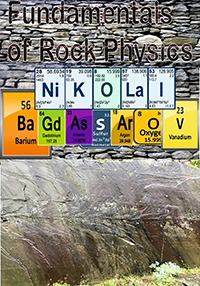
“The most reliable and trustworthy geophysical tool is a geological hammer!”
“The most reliable and trustworthy geophysical tool is a geological hammer!” This remarkable statement of his father, an experienced geologist, Nick Bagdassarov had to hear many times in his childhood. Even then it became obvious to him that being a geologist is a difficult, and sometimes ungrateful, fate. Apparently, therefore, he tried to correct and refute this judgment about the traditional methodology of geosciences in this new book on physics of rocks.

In his book – a textbook for students studying Earth sciences, Nick tried not to refer readers to fundamental books on elastic mechanics and solid state physics, fluid mechanics, nuclear physics and magnetism, but rather to present elementary the physical and mathematical background of rock physics by means of Focus Boxes inserted in the main text on rock and mineral properties. This text book is conceived after the lecture course that the author gave for over 20 years at the Goethe University in Frankfurt am Main for ungraduated and graduated students at the Faculty of Geosciences. Nick is an author of a number of papers, mostly dealing with mechanical and electrical aspects of the frequency dependent rock properties applied in geophysics for the determination of various geologic structures.
“Fundamentals of Rock Physics” consists of 12 Chapters (density and porosity, stress and strain in rocks, permeability and poroelasticity, elastic moduli and wave velocities, electrical and dielectric properties, rock magnetism, thermal properties and rock natural radioactivity) and covers all aspects of physical properties of rocks on a wide range of physical scales from mineral grains to the tectonic plates on the Earth, reflecting the broad interests of the author to the essential physical mechanisms involved in geomaterial formation and evolution, and the mathematical description of the multiple scales of rock heterogeneities.
In the book Nick tried to produce a unified treatment through the book text, with consistent notations and explanations, suitable both for undergraduate and graduate students wishing to study rock and mineral physics and for experienced researchers.
Each Chapter of the book is a separate lecture with problems to solve at the chapter end, the solutions of which are given in the online Appendix. Students may read and learn forward to approximately one new Chapter per week. In parallel with solving of physical problems, for a better illustration of chapter contents the author proposes to solve some typical problems using MATLAB, the codes of which are also available online.
Additionally, the author believes the book ideas have to be applicable in the real geology.
Latest Comments
Have your say!